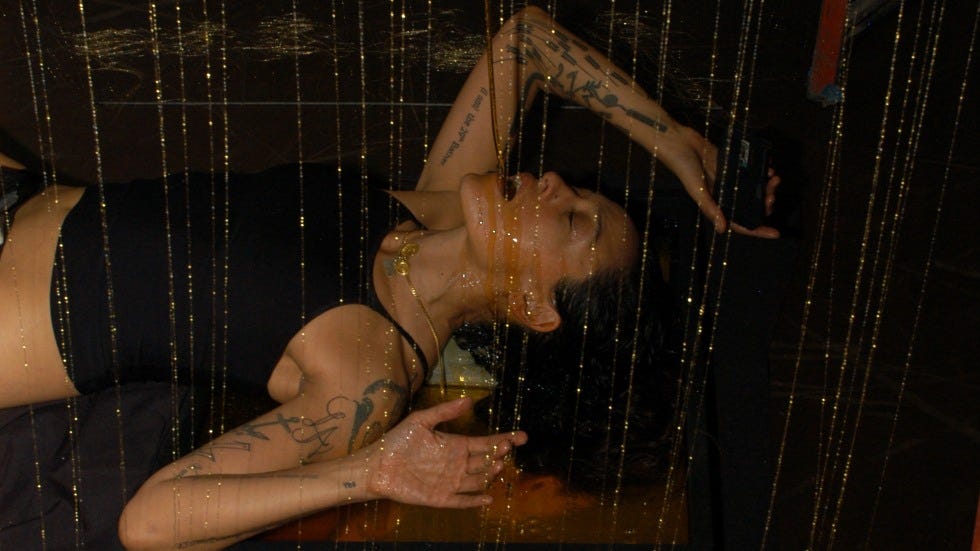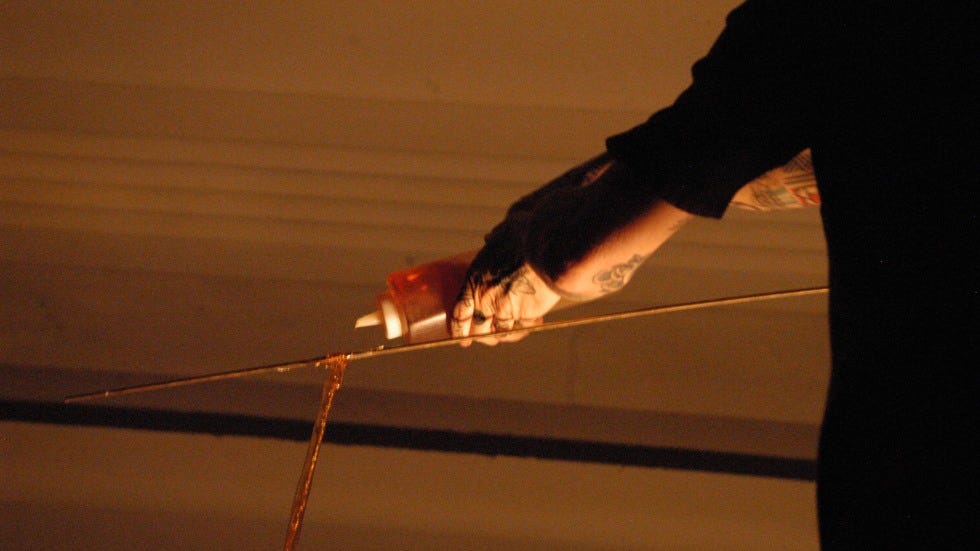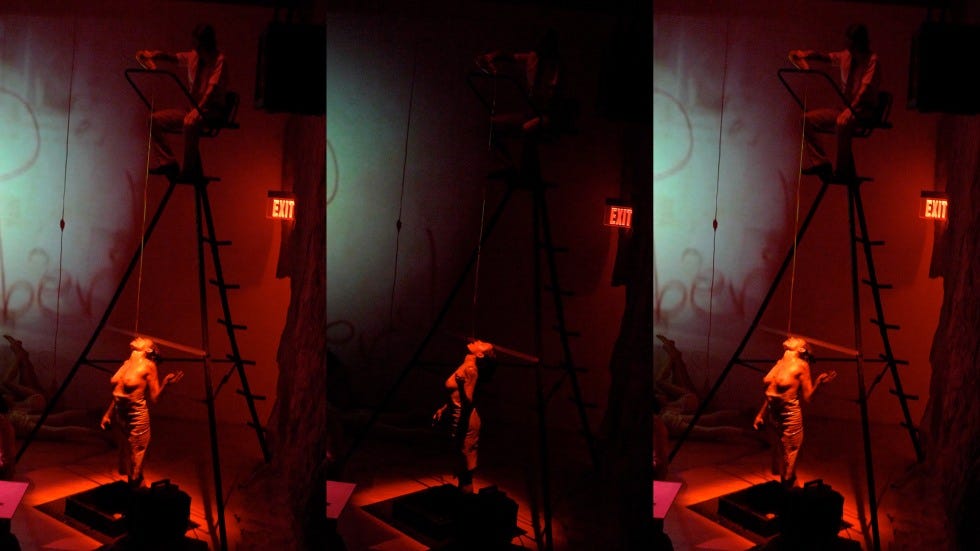Oh, Honey: Allowing the Real Thing That’s Happening to Happen
This week, I wanna tell you guys about this one feminist performance art piece I learned about at my public liberal arts college in 2015.
When I was in college, I took a class called “Performing Feminism,” taught by a professor who, years after I graduated, would get cancelled on Twitter for being an asshole to her students. The class closely examined feminist performance art, or the act of “performing feminism,” from the “(post) Civil Rights era to present day in the visual arts, politics, popular culture, and everyday life.” As a poet (and, at the time, a slam poet), I loved this class. I still think of and reference some of the performances we observed.
In a dark classroom, illuminated by the soft-humming projector, we observed an artist stand, arms outstretched, beneath an 8-foot-high ladder as an assistant perched at the top poured a steady stream of honey down the artist’s throat. The performance, observed by an audience, employed 50 pounds of honey and lasted hours as the two artists held their positions — one pouring, the other receiving, ingesting the honey with their mouth held perpetually open in an “O” shape. The receiver holds their position, always ingesting the honey, with two different recording devices in each hand playing snippets of music intended to ground and center the performer in their trance-state of consumption, honey overflowing from the mouth, down their neck and shoulders, until they are absolutely covered, sticky and golden.
I am haunted by the honey performance. Eventually, I forgot the name of the artist, but I could not escape the image, the concept: the constant consumption, the use of the body as an art tool, the limits to which artists should (can and will) push themselves for the sake of art, for the sake of making a point, to allow an audience to come to their own conclusions.
Last night I googled “honey feminist performance art” and found it: Honey by Julie Tolentino, performed with her partner Stosh Fila (aka. Pig Pen). Julie and Pig Pen have toured together for 15 years presenting their art around the world, including Honey, which entered the rotation in 2009. It was performed for the last time in October 2024 as part of Brown Arts’ IGNITE Series, described as a “durational performance and queer choreography of the throat.” (Tolentino currently teaches a class at Brown called “Body as Medium.”)
See the 2024 description below:
HONEY is a durational performance by Julie Tolentino and Stosh Fila. Viewable from different vantage points, Fila releases liquid globes of honey onto thin metallic gold threads as Tolentino swallows the weighty, sticky fluid over a three-hour interval. HONEY has been presented across the world since 2009 in artistic and academic settings as a form of collective study. Reflecting pressured, receptive, and resistant spaces of connection, the work aims to respond to the contexts in which it is performed. At Brown, HONEY’s final live iteration is accompanied by projected archival video documentation and is hosted by the Department of Modern Culture and Media's Elemental Media Conference.
“It actualizes this really intense, tender, loving, at times painful, endurance of both the body and consumption,” Leon Hilton, an assistant professor of theater arts and performance studies, told The Brown Daily Herald in October.
The 2024 performance included archival footage of previous iterations. In some, she’s laying down, such as in the 2009 performance in Berlin, where in others, such as her 2011 adaptation at MOCA in Los Angeles, she is standing. In some performances, Tolentino is wearing a leather skin dress wrapped around her torso and, depending on the amount of honey overflowing from her mouth, it will saturate the fabric and cause it to drop, exposing her chest. (She edited this aspect of the performance for one iteration at NYU Abu Dhabi in 2014.) In 2013, a performance of Honey allowed audience members to participate, to understand how hard one had to squeeze the bottle to make the honey come out. Sometimes lasting over five hours, Honey is a durational performance testing the endurance of both the artist and the audience.
“There's just one action, you know: Craft the globes. And I just wait with my mouth open for the honey to drop into my mouth,” Tolentino said of Honey in a 2018 interview for the “Archives of American Art's Visual Arts and the AIDS Epidemic: An Oral History Project.”
“I am trying to articulate the kind of directness of communication between people. And the loss of information, the stickiness of it, the libidinal quality and the kind of sensuality of what communication can be like or what communication offers,” they said. “Also, I think that I'm expressing the opposite of that, which is the difficulty of being able to speak, the distance between people, the ways that you can hear what you want to hear. You know, like it can just be a one-way receipt. The way that the thing that you're crafting kind of ends up in a whole other state. I would like to think of that work as always working on me, and working on us, as challenging as it is to be a viewer.”

“But, you know, I think that the piece really offers something that I don't mean to happen, which is that, you know, there is some suffering in that piece. So, I'm not afraid of the suffering. I mean, I'm not afraid of demonstrating — but I'm not performing. I'm not affecting the performance of it. I'm just allowing the real thing that's happening to happen.”
I like that: allowing the real thing that’s happening to happen. Especially when it comes to art, when it comes to the body, when it comes to being. Obviously, my thinking about work like this has increased as more money is funneled into AI — we should talk about art that makes us uncomfortable, that haunts us, that is uniquely human, that stays with us even when we’ve forgotten the artist’s name, that can only exist within the context of the human body.
That’s all I got. Happy Friday, team.





